And I was right...story of this church is great historical revelation of life in Manhattan---
St. James' Episcopal Church (New York City)
From Wikipedia, the free encyclopedia
| St. James' Church, New York City | |
|---|---|
| Denomination | Episcopal |
| Located | Madison Avenue and 71st Street New York City |
| Founded | 1810 |
| Rector | The Rev. Brenda G. Husson |
| Diocese | Episcopal Diocese of New York |
| Website | http://www.stjames.org |
Founded in May 1810 as a summer chapel for New Yorkers with country homes north of the then city, it has grown into one of the largest Episcopal churches in New York City. In addition to worship, it has programs for children and young families, youth and young adults, as well as a music program and a devotion to mission and service in the community.[1]
Contents
Worship & Music
St. James' Church worships in a variety of styles within the Anglican tradition. Four services of Holy Eucharist are celebrated every Sunday.[1]Music
In 2008–2009, the parish installed the St. James' Bicentennial Organ, built by Schoenstein & Co. Organbuilders (op. 156 & 157) in San Francisco. The organ contains a total of 5,538 pipes, with 4,407 pipes in the chancel organ and 1,131 pipes in the gallery. The new organ was dedicated in October 2010.[2]Art and Architecture
First ChurchSt. James Church began as a summer chapel for New York City residents who had country homes above the banks of the East River. The first church was built in 1809–10 on Hamilton Square, at what is now East 69th Street and Lexington Avenue, and was consecrated by Benjamin Moore, Bishop of New York, on May 17, 1810. This simple building, with clapboard siding, grey shingles and quaint belfry served the congregation until 1869.[2]
Second Church
The second church was built in 1869 on East 72nd Street. Designed by James Renwick, Jr. in the Victorian Gothic style, it was understood to be a temporary home as the church continued to grow with the neighborhood around it. Renwick had achieved fame as the architect of the Smithsonian Institution in Washington, D.C., as well as St. Patrick's Cathedral and Grace Church on Broadway, both in New York City.[2]
The Third Church
Work began on the present church in 1884. Designed by R. H. Robertson, it opened in 1885, though it never received the tall tower that Robertson had planned. Built in the Romanesque style, it was deliberately disoriented, facing west, with the apse on the Madison Avenue-end so that no new construction would block sunlight from reaching the chancel windows.[2]
Cram's Rebuilding
In 1924, the great Gothic Revival architect Ralph Adams Cram was hired to enlarge and transform Richardson's Romanesque building into the neo-Gothic building enjoyed today.[3] As a cost-saving measure, Cram retained the existing roof structure and most of the exterior rock-faced brownstone walls, while the main entrance was relocated to Madison Avenue. A new chancel was added at the east end, extending the length of the church by half, complete with a new Spanish-themed, painted and gilded Reredos. Most of the stained glass windows were removed and replaced by windows executed by studios under Cram's direction, though several windows by Louis Comfort Tiffany Studio were preserved in other parts of the church. The Church reopened at a candlelight Christmas Eve service in 1924.[2]
Because the stonework in Cram's original 1926 tower was beginning to crumble, the parish replaced it in 1950 with the present "tin can" steeple designed by Richard A. Kimball.[4]
Master Plan Renovations
Beginning in 2001, the church and parish house were completely rebuilt, from the inside out, according to plans drawn up by the architect Lee Harris Pomeroy. The floor of the sanctuary was demolished and rebuilt with new steel structure and stone. Having outgrown classroom and meeting space, the undercroft beneath the sanctuary was transformed into additional Sunday school rooms. The parish house was completely rebuilt between 2002–2004, providing additional classrooms and meeting spaces, as well as a new glass atrium in the previously unused exterior space between the parish house and sanctuary. At that time the entrance to the parish house was also reconfigured so that the entire complex would be accessible. In 2005 a new Columbarium was constructed in the bell tower. Several Tiffany windows, hidden and in some cases reconfigured during Cram's renovation, were also restored.[5]
In 2008–2009, the parish installed the St. James' Bicentennial Organ, built by Schoenstein & Co. Organbuilders (op. 156 & 157) in San Francisco.[6]
Recent History
The parish sponsored Carol Anderson, who in 1977 was ordained to the priesthood at St. James' Church as the first woman priest in the Episcopal Diocese of New York.[7]Under the leadership of Hays Rockwell (1976–1990), the parish invited neighboring churches and synagogues to form the Neighborhood Coalition for Shelter, a drop-in center providing immediate and long-term assistance to the homeless.[8]
During Rockwell's tenure, the parish also developed particularly close friendships with Bishops Desmond Tutu of South Africa and Gordon McMullan of Northern Ireland,[9] supporting them during their respective times of trial. St James' was one of the first churches to divest from investments in South Africa, and encouraged others to do likewise.[10]
In 1996 St. James' called as rector the Rev. Brenda G. Husson, the first woman chosen to lead a parish of such size and prominence in the diocese.[11]
Under Husson's leadership, St. James' received a large private grant to establish the Partners in Mission program. The PIM grant currently supports ongoing partnerships with the Anglican Diocese of Southern Malawi in Africa,[12] three Episcopal parishes in Haiti, as well as regular work with the Osborne Association's outreach to children with incarcerated parents in New York.[13]
St. James' was invited to participate in the Lilly Endowment's nation-wide Transition into Ministry program for the mentoring of new clergy. The position of 'Lilly Fellow' was created in 2003 to train new priests in all aspects of parish life.[14]
St. James' celebrated its bicentennial year in 2010. The parish welcomed Katharine Jefferts Schori, Presiding Bishop of the Episcopal Church, for a festive service marking the culmination of the bicentennial year on November 14, 2010.[15]
Rectors
- Samuel Farmer Jarvis (1811–1819)
- William Richmond (1820–1837)
- James Cook Richmond (1837–1842)
- John Dowdney (1842–1847)
- Edwin Harwood (1847–1850)
- Peter Schermerhorn Chauncey (1851–1866)
- Cornelius Bishop Smith (1867–1895)
- E. Walpole Warren (1895–1903)
- Frederick Courtney (1904–1915)
- Frank Warfield Crowder (1916–1932)
- Horace William Baden Donegan (1933–1947)
- Arthur Lee Kinsolving (1947–1969)
- John Bowen Coburn (1969–1975)
- Hays Hamilton Rockwell (1976–1990)
- Mark S. Anschutz (1992–1995)
- Brenda G. Husson (1996–present)
In Popular Culture
- The 5:00PM St. James' Christmas Eve service of Lessons and Carols was broadcast over the local WOR and WQXR radio stations in New York City as early as 1934, and then annually from the early 1950s through 2000.
- St. James' Church was the site of funerals for both John Steinbeck and Edward R. Murrow.[16]
- The exterior and interior of St. James' have been seen in Gossip Girl (CW television series).[17]
See also
Episcopal ChurchAnglican Communion
Book of Common Prayer
Christianity
External links
Further reading
James Elliot Lindsley. A History of St. James' Church in the City of New York 1810–1960.Francis J. Sypher, Jr. St. James' Church in the City of New York, 1810–2010. (New York: St. James' Church, 2010).


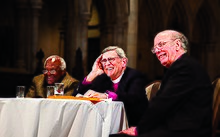

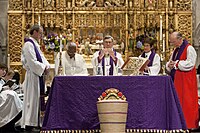
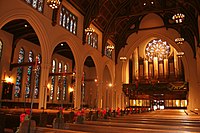
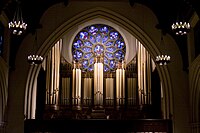
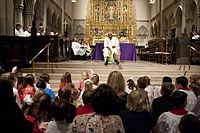
No comments:
Post a Comment
Please leave a comment-- or suggestions, particularly of topics and places you'd like to see covered